M/Cing to SA: Searching for pisco,penguins, and porpoises on the Chilean coast
We go 500 miles over land and sea up the Chilean coast
Little on this trip is going as expected, which I guess, should be expected. I spent two years building the ultimate around-the-world motorcycle only to get less than 100 miles out of Buenos Aires before hitting mechanical trouble. I thought KR would love Mendoza only to hear her decry it ugly. I thought we’d zip through the big cities like BA, Mendoza, Santiago and Valparaiso, only to spend the majority of our time there. And, most surprising, I thought we’d be into Bolivia by now and we’re still more a 1,000 miles south.
So much for expectations.
Expectations come and gone
- Relative to other parts of the world, this is going to be an inexpensive trip. Aside from all the added expenses due to NV’s late arrival and the series of mini-disasters this caused, Argentina and Chile have been expensive. Hotels can easily range from $75-$150/night unless you get lucky and downgrade to a B&B. Then you’re looking at $40-60. Gas? Somewhere around $6/gallon. Food? Yesterday we spent $55 at lunch for a very mediocre meal. We’ve found few things to be consistently cheap, and Chilean and Argentinean wines for less than $5/bottle for something very decent is one of them. Clothing made in Chile and Argentina is less expensive as well as ismost labor.
- Why so expensive? A number of things conspire to make it expensive for tourists like us. Its high season in Chile/Argentina and prices can double/triple from low season . There are huge import taxes aimed at keeping cheaply made foreign goods out of these countries. Electronics, cars (not produced in country), motorcycles, and imported clothes are 25-50% higher because of taxes. One of the motorcyclists that we met paid $75,000 for his high end BMW motorcycle in Brazil, a bike that would cost $20K in the US.
- Chile and Argentina are developing countries. Not in the macro economic sense and certainly not in the cultural/civilization sense either. These countries have cities that would easily compete with modern cities anywhere in the world. Argentina is the most Internet-connected country I’ve visited. The sense of style, art, and fashion in Santiago or Buenos Aires is far ahead of most US cities. This is not to say that there aren’t really poor areas of both countries, which there are, but I’m not sure their poor are any more poor or widespread than in the US.
- The US Dollar is still mighty. Not so, especially in Chile where the dollar has sunk from being worth about 6 Chilean pesos to slightly less than 4 in the last several years. While we could easily pay with the dollar in Buenos Aires, people in Chile won’t accept it unless there is no other alternative. It makes one wonder what the future will bring given our growing, immense debt and the habit of printing more money to meet its demand.
- We can travel fast and easy. Geez, how wrong can one be? We’re more than 30 days into this adventure and we’re at our original 10 day mark. We’ve already written that the easy part hasn’t arrived just yet.
- The roads will be horrible. Most of the main roads are as good as any in the US. Even the non main roads are good pavement and well maintained. As one gets into the more remote places, the road can turn into gravel pretty quickly, but that would be the case in the Southwest as well. Yet, we still expect the roads to get a lot worse in Bolivia and Peru, two of South America’s poorest countries and the next two on our target list.
- This is perhaps the most obvious: BMW motorcycles are rock solid. This is the subject of posts in the past and I’m sure in the future, so I’ll just cut to the chase here. I expected to have bike problems with everything from flat tires to fuel pumps gone awry. I didn’t expect to question one of the bike’s most basic systems and capabilities: can the thing run without overheating in anything other than a pleasant spring day? We’ll find out.
Norte Chico
I’d been waiting for more than a year to show KR the coast immediately above Valparaiso (called Norte Chico), as I remembered it to be some of the most dramatic I’ve seen; long, long beach’s with huge breakers curving far into the distance. Driving along the Pan-American Highway one might think they were in one of Northern California, Oregon or Washington’s remote beaches.
We stopped often, looking for that perfect charming town that I could show KR. We didn’t find it, of course. Perhaps it was out there, but it was at the end of a dirt road and KR (and admittedly me) weren’t in the mood for too much adventure just yet.
Our destination this day was Chile’s second oldest city and major vacation destination for Chilenos with money -La Serena. I’d been there before on the 2010 Dakar Chase and remember it as a seaside resort in the most brazen way; miles and miles of beach populated with semi-modern two star hotels/motels. I remember its El Centro as being quaint, old and interesting. I was convinced that KR would love it.
So much for expectations.
La Serena
We get to the edge of La Serena and KR comes over the intercom, “It shouldn’t be too hard to find a place to stay, there’s not much there. Let’s find a coffee shop with Wi-Fi and look for a place…” Sound familiar? An hour later we’re still crunched in by La Serena’s traffic and there are no (1) coffee shops in sight (2) no Wi-Fi; and (3) we didn’t have the foggiest idea of where to stay. All three of us were getting cranky. A friend, Bruce Conrad, comes to our rescue as he had earlier emailed a suggested hotel in case we needed one. We decided to cut to the chase and find Hotel Del Cid, which we did after a couple of tries. The Del Cid lacks charm, is way over-priced, but is in a great location, had a charming Irishman for a proprietor, and was available. We paid our $80, unpacked quicker than you can say beer in Spanish, and hit the streets. We had a drink or two (of course), ate at La Serena’s finest restaurant, and called it a night. The next day we packed with surprising efficiency, had one of the worst (but not THE) breakfasts, and made a hasty exit from La Serena. I expected to continue going north into the Atacama, but KR had other ideas.
So much for expectations.
Into the valley of the Pisco grape
Instead, we went 65 miles east into the Elqui Valley to explore Chile’s main Pisco grape growing region. The Pisco grape is the basis for Chile’s favorite drink, the Pisco Sour, and is certainly popular if judged by the number of vineyards. I’d never heard of this place (no expectations) which turns out to be one of the prettiest places we’ve been to. The valley descends from the higher altitude Atacama mountains in a contrast of colors. Because it’s so narrow, the barren, brown mountains butt up against the green vineyards of the Pisco growers. Add the Chilean taste for painting houses bright colors and the mineral laden Elqui River into the mix and the valley is full of vibrant images. As we wind up the valley, and eventually one of its off-shoots, we pass through small villages clinging to the hillside. Each one has a couple of stores, perhaps a hostel or two, and a mini town square. We make it to the village of Pisco Elqui for the night. Not willing to deviate from our successful strategy, we pull into Pisco Elqui without a place to stay. This time we get lucky and find the Hotel Elqui right in the middle of town. For $20/person we get a room, no bathroom and (THE worst) breakfast. We spend another night walking its few streets, shopping in the tourist shops, and having dinner. With no TV, one reading-light, and no electrical outlets, we’re asleep early in preparation for our push north into the Atacama.
Not so fast, says my dearest. “I want to go see the penguins.” Penguins? You might be surprised to know that I’m something of a penguin expert having seen the Little Guys in their Patagonia habitat and actually paid to see a penguin movie. I know that penguins are in Antarctica and Patagonia, not northern Chile. “Not true,” says mi epousa, “there are penguins on a little island off the coast of Punta de Choros, about 45 miles north of La Serena.
So much for expectations.
Over land and sea searching for penguins and porpoises
After a beautiful ride down the Elqui Valley, a gas/cash/water stop in La Serena, and a 45 mile ride up Ruta 5, we come to a sign that points off into the distance toward Punta de Choros. We are now in the foothills of the lower Atacama. We have long since left the seaside behind and we’ve been slowly climbing inland. There is nothing around but the sign: “Punta de Choros 42 kilometers” pointing down the gravel road. What to do?
We’re unsure whether our appetite for adventure has reached the level of 42 kilometers of riding on a gravel road to a place we’re not sure that there’s anything except a couple of fishing boats to an island that we can see the ______ penguins. We go back and forth on what to do and finally KR says, “Let’s go!” and off we go.
Twenty-seven miles of gravel road later, we roll into Punta de Choros with huge smiles of relief under our helmets: we made it! It’s sunny, and there’s a beautiful ocean right in front of us. It’s kind of a cute little town, in a wind-blown South American way. Moreover, we quickly score a cabana overlooking the beach that becomes our favorite place to stay so far. To make up for its cost ($110/night), we cook dinner in and chill for the night. Actually, I’m ready to chill tomorrow as well but I know there’s no chance of that happening. We’re going to look for the _____ penguins.
I like my planes and boats the same way: big. I’m sitting on the porch of our cabana and watching all the tourists boats push through the waves, loaded with happy penguin hunters. These boats could be described in lots of ways, but big isn’t one of them. These craft make the water taxi from Boca to Little Big Sur look like a cruise liner. I’m searching for any excuse to beg off this expedition, but no opening presents itself.
The next afternoon we board one of these vessels with a dozen other penguin hunters, then slowly (thank god) putt-putt our way out toward two islands, about five miles away. Our two-hour trip (120 minutes and counting) includes a cruise by both islands looking for assorted wildlife. We join a small armada of other puny little boats with lots of penguin hunters as we hug each island’s rocky coast. For the first hour we see lots of different kinds of birds, but no penguins. Then onto Island Two the action picks up. There! Up there! Yes, folks, it’s a tiny, brown totally bored penguin. A dozen cameras go click-click and I feel a sense of relief: there’s no chance we’d have to come back out here again if we hadn’t found the little guy. Soon he is joined by a dozen other dirty, brown, small penguins and I know we’re AOK to go back to terra firma.
Not so fast. We’re going to look for seals and sea lions, and maybe some dolphins or porpoises later on if we’re lucky. I hope they’re close by. Sixty minutes and counting. The seals and sea lions come fast and our pretty damn amazing. I’ve never been that close to them in their “natural habitat” and it’s engrossing. They don’t seem to mind the three boats floating just feet away from their rocky perches. Comes with the territory, I guess.
Trouble on the dolphin front emerges. To find the dolphins, we need to go out and around the islands and into the open sea. Because there are lots of rocks around, there are huge breakers even this far out. We’re going “out there” our captain says (OK, he’s pointing in that direction and my fellow penguin hunters gasp is shock. I don’t’ have the slightest idea what he’s saying). We start the plowing up and down the waves and the guy next to me is getting sick. I synch up my life-saver and think if this thing sinks, we can probably back-paddle to the rocky shores. But then what?
We get out past the breakers and the ______ dolphins are no-where to be seen. Geez, give me a break! Who cares? Go to Sea World, you can see whales too! The guy next to me has his head between his knees, not wanting to look up. Then someone shouts pointing in that direction over there. Before you can say “there she blows!” two other puny little boats chocked full of penguin hunters emerge from the waves and there’s a race to something off in the distance. Look! Over there! There is a god as we see a gaggle of fins bob up and down. All three boats chase the dolphins for about twenty minutes before we’ve all had our fill and agree to head back to the pier. Thirty minutes later I’m in our cabana tossing down pain killers and thinking I survived the puny little boat full of penguin hunters. The 27 miles of gravel road back out tomorrow will be a piece of cake.
But I’m thinking, “be careful of expectations.”
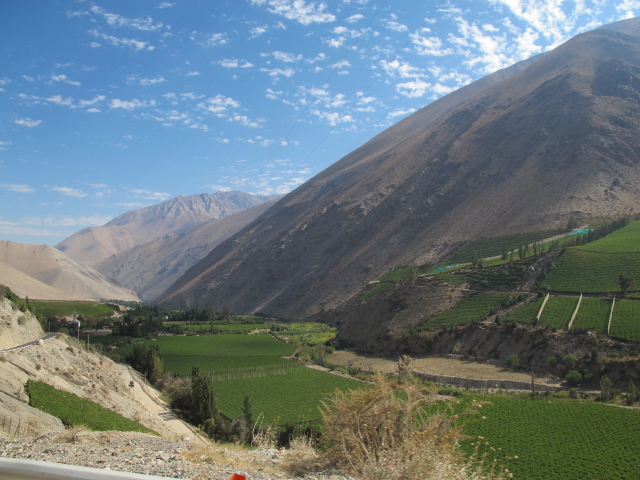
Going up the Elqui Valley was gorgeous. Pisco grapes are used to make Brandy and Chile's favorite drink, the Pisco Sour.
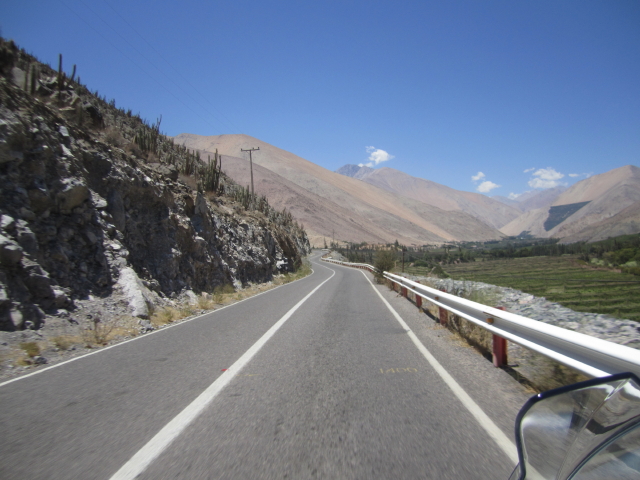
The road through the valley was glass smooth, fast and curvy. Great road, great views, special place.

We stayed at the Hotel Eiqui. It's been run by the same family for 50 years. They have some unique thoughts on inn keeping
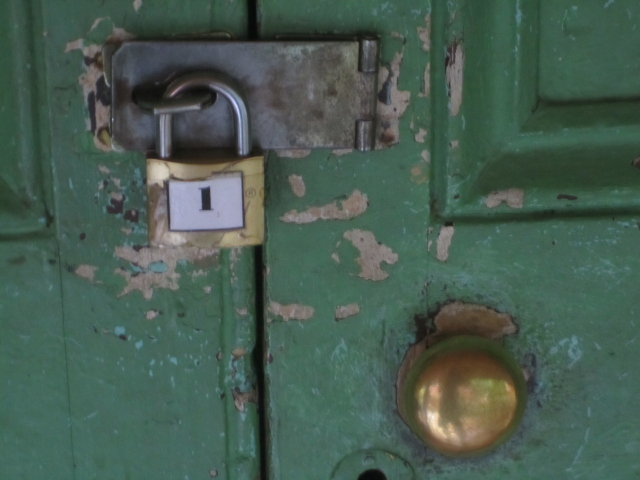
This is the lock to our room. It works, and for $20/night per person, no one's thinking there's anything in these rooms worth stealing.
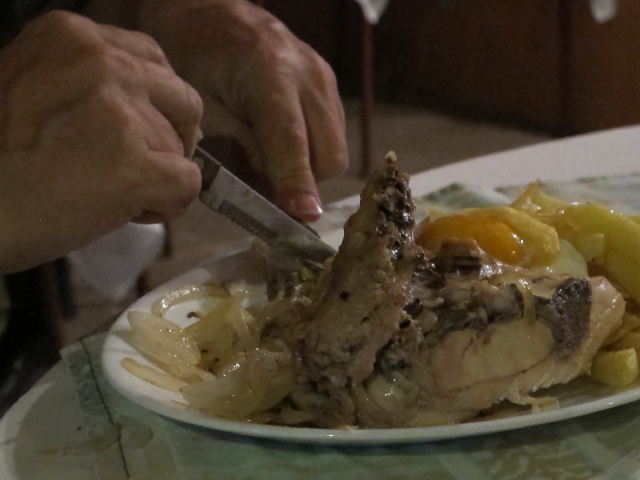
The Hotel Equi has a unique perspective on food as well. KR and I are both in agreement that we don't have the slightest idea of what' in/on this chicken. Not caring, I think it tasted great, but KR decided to pass. Cost of dinner? $8.00
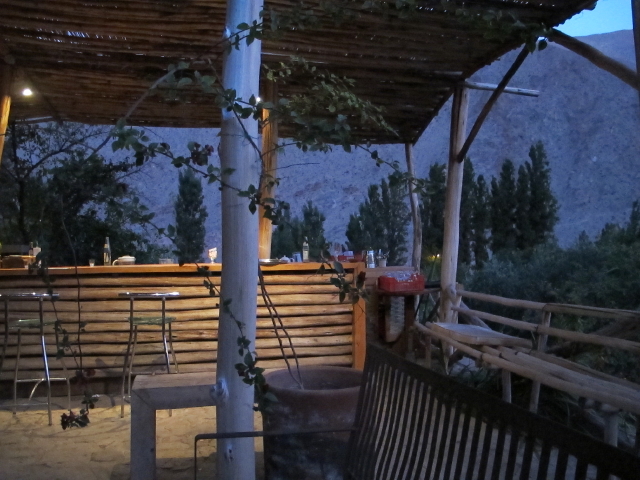
It's hard to explain the juxtoposition of "now" and "then" in these remote villages in Chile. This restaurant/bar was immaculate and would feel right in Laguna or Malibu (providing they had the Andes at their doorstep). Yet, right outside this restauant's door is the village square which looks like its been relatively untouched by gringo tourists.

This picture makes me mad. Whenever one gets on a road that goes up the Andes --whether on the Chilean or Argentinean side, you can count on it being full of very young trekkes intent on hiking over it carrying huge back packs. How can they do that and still be smiling?
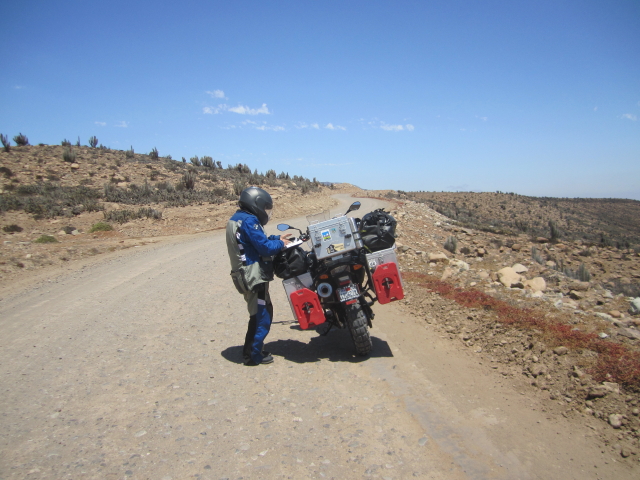
Checking the map twice. 45 miles north of La Serena is the turn off for Punta de Choros, home to penguin and porpoise tourist boats among other things. The problem is what you see in this picture -- 27 miles of dirt/gravel road between the desert mountains and the desert coast. After much soul searching and talking quietly to Now Voyager, we launch down this gravel road to search for penguins.
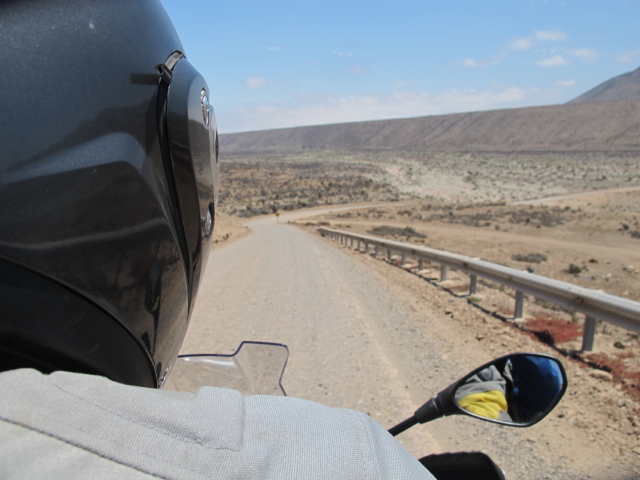
Here's the problem with something like this: not knowing what lies ahead. Will the "road" get better, stay the same, or get worse? Because NV and FW have limited capabilities on the dirt, we're very concerned that what lies ahead is something we can handle. Makes for a long ride
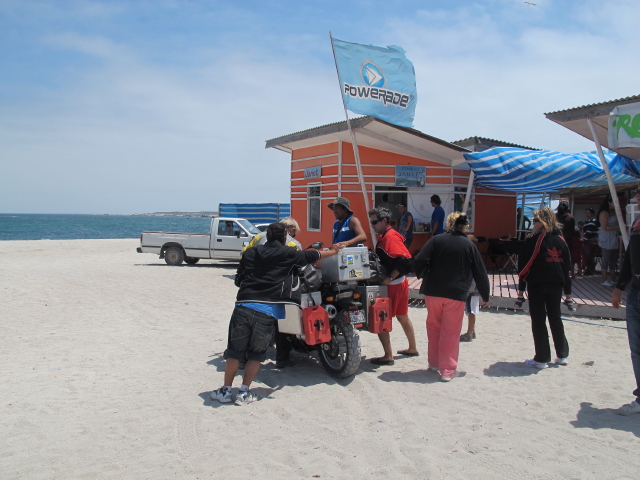
to have FW drop NV twice in the sand, trying to get lunch. Each time requires a crew of three to right it. Right after this picture, I make another successful escape from the sand with the "hawker"of the beach bar giving blow by blows over the loudspeaker...
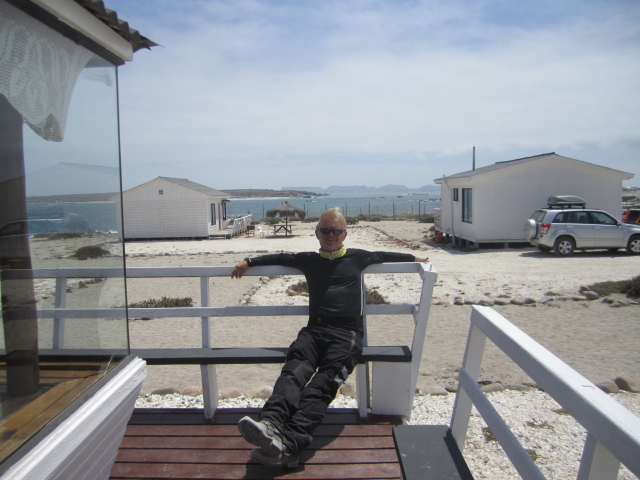
Happy camper. We get lucky and find a beach cabana with a great view, kitchen, two bedrooms and a dining room feet from the beach. We decide to stay two nights.
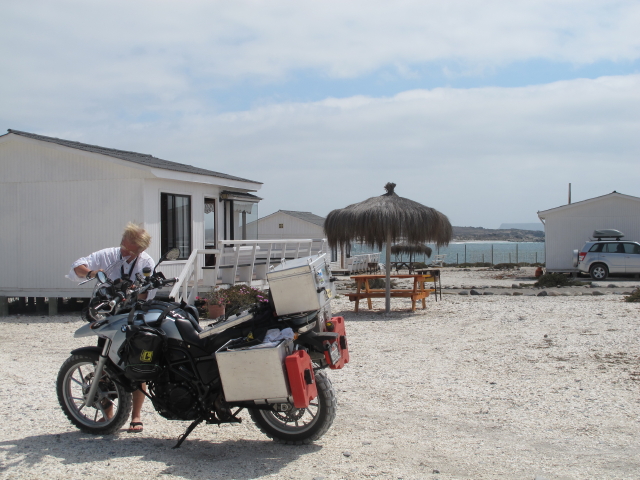
Every cowboy's first responsibility is his horse. I check that nothing has come loose nor have we sustained any damage from my two tip-overs. All systems go!

The next day we sign up for a penguin hunting expedition to two islands five miles out. I like my boats and planes big. Our craft doesn't quite measure up.
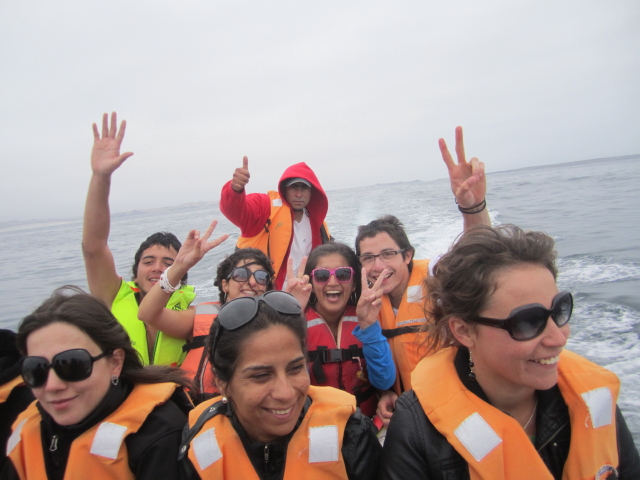
Everyone (but me) is in a party mood on our way out to the islands, five miles off shore. It gets decidedly more quiet accented with grasps when they see the breakers we have to go over/through to get to dolphin territory.
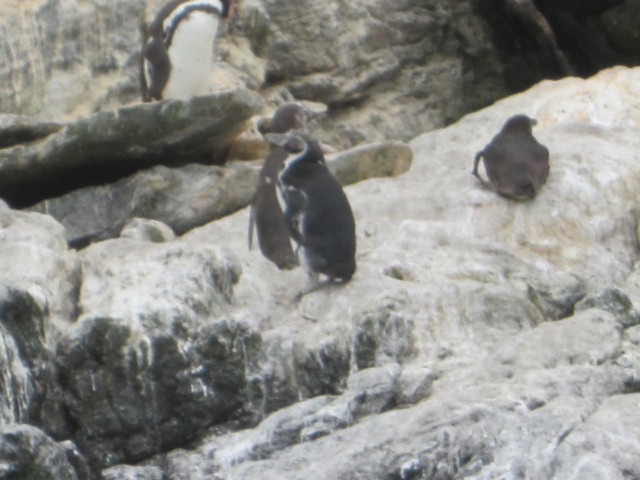
Look closely for the object of our lust. These penguins were less than impressive, but they probably thought the same of us.
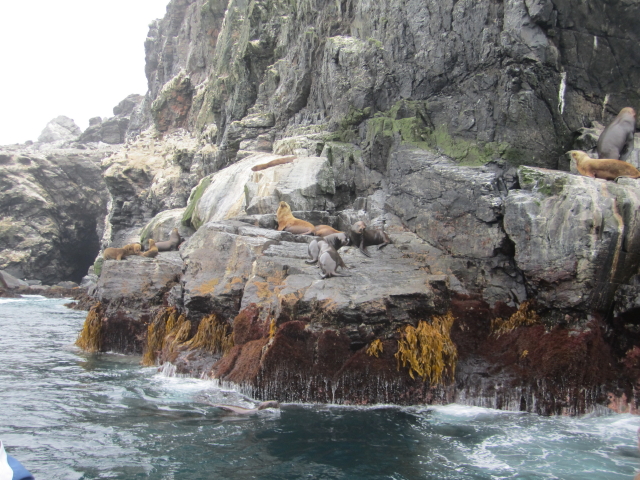
The sea lions and seals were an unexpected treat. I'd never seen them in their "natural" habitat and it was fun being a few feet away as they played and fought.
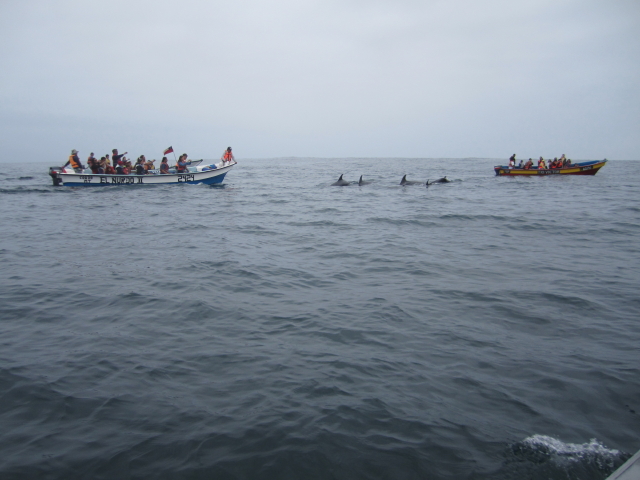
AFter a chase that included going over the breakes, our armada of puny boats loaded with penguin hunters get to see dolphins up close and personal.
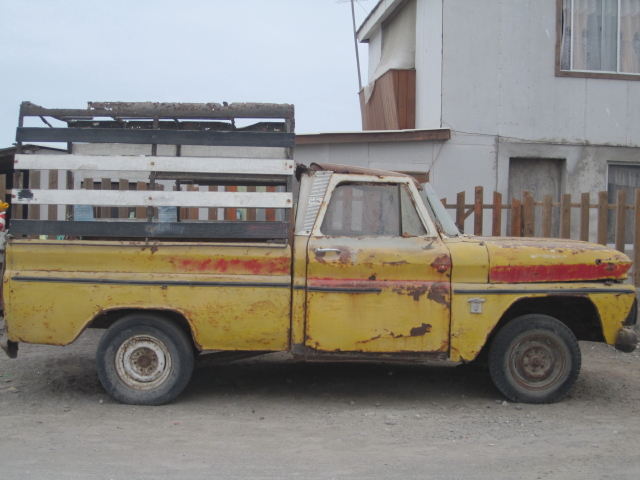
Just an old truck? No, this is a advertisement that the fine gentlemen inside sells gasoline. He can afford a better sign as our 2 litres cost roughly $14.00.
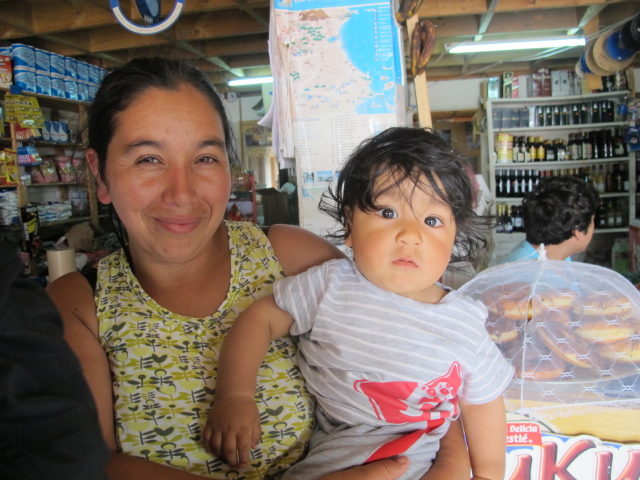
KR keeps telling me to put in more pictures of the people we meet along the way. This mother and child are in a mini mercado in Punta de Choros. I think the kid's expression captures KR's surprise that we made it down the dirt road in one piece:)
The situation as of 10:30AM on Sunday, January 30th in Copiapo, Chile. Much to our relief we made it back down the gravel road and the 150 miles of the Pan-American Highway to this mining town. Some of you might remember it as the location where the 33 Chilean miners survived more than three months in a mine nearby. We’re staying an extra day in order to catch up on things and then we’ll head north into the heart of the Atacama on our way towards Antofagasta.
We’ll keep you informed as things unfold.

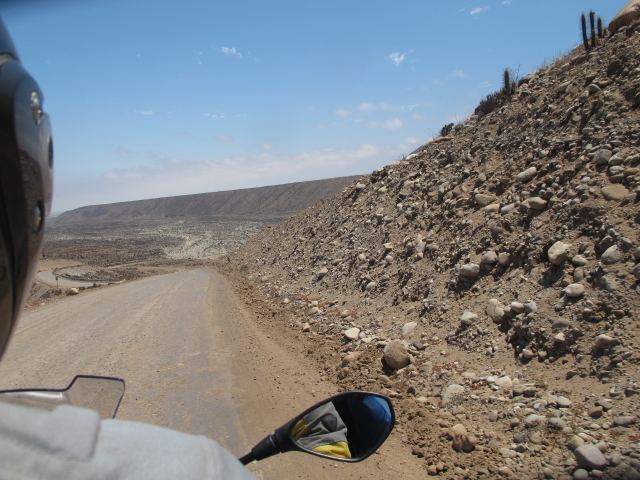

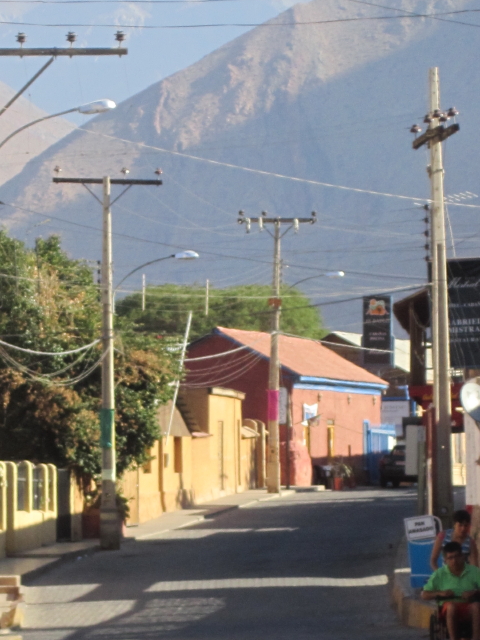
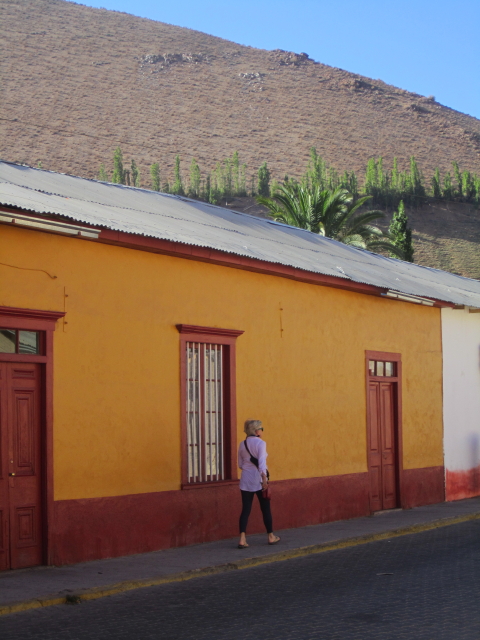
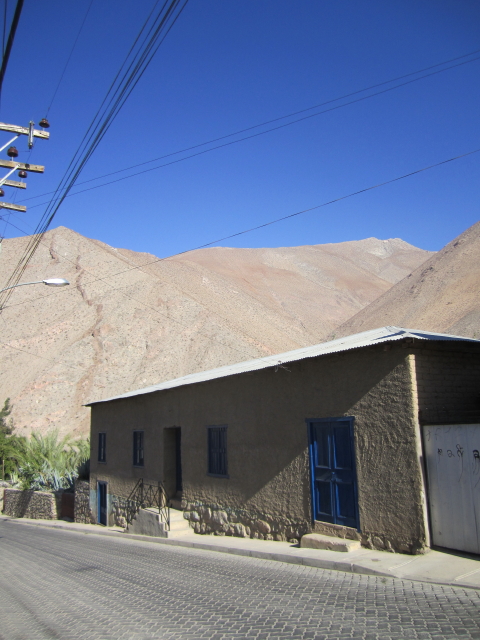
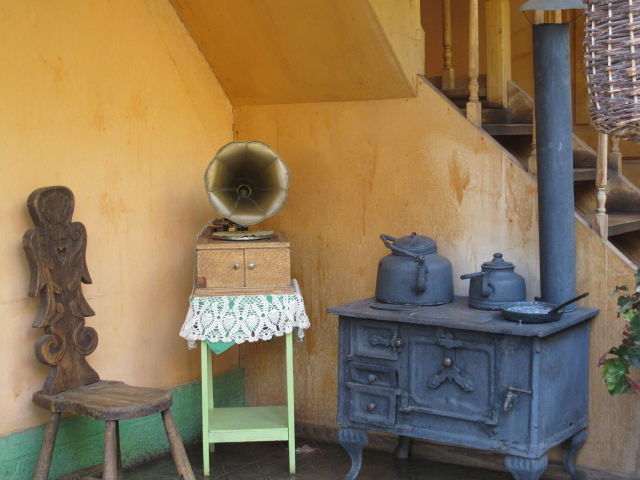

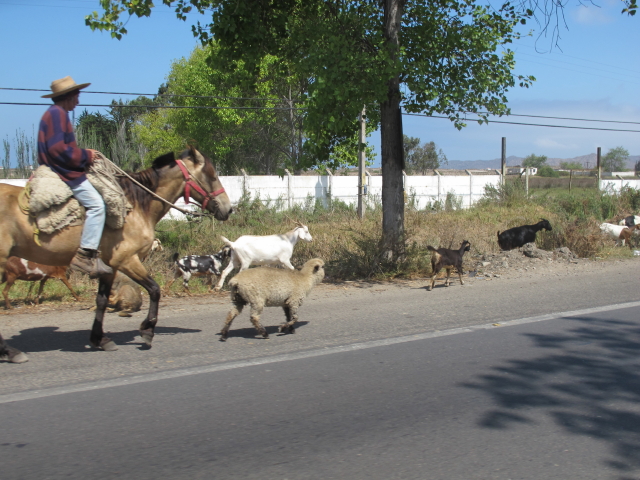
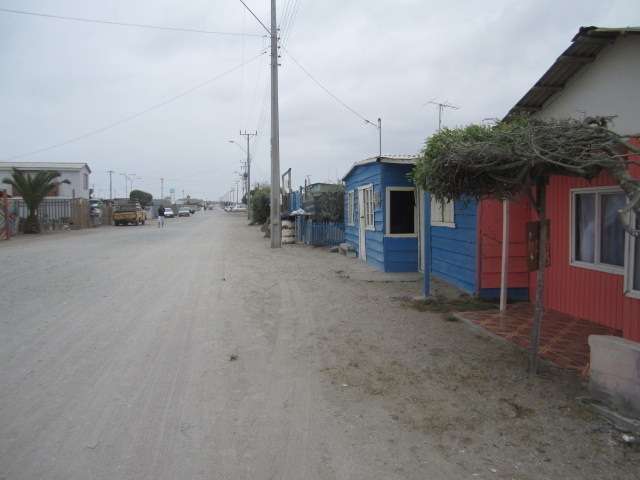
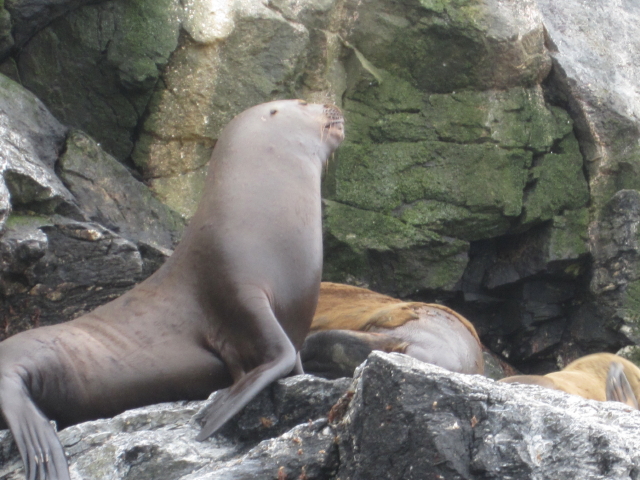
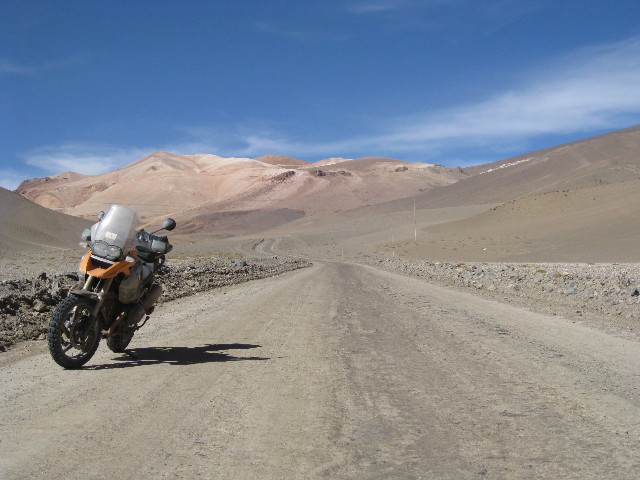
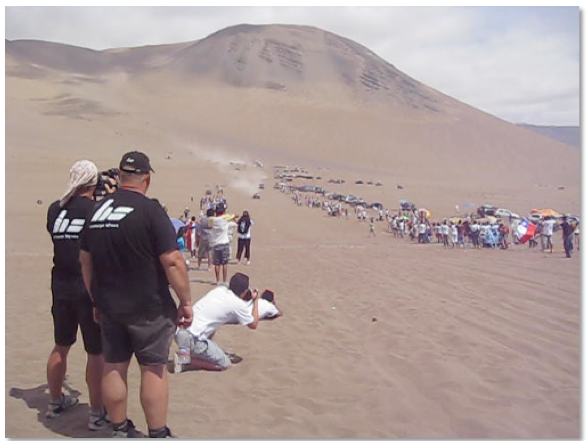
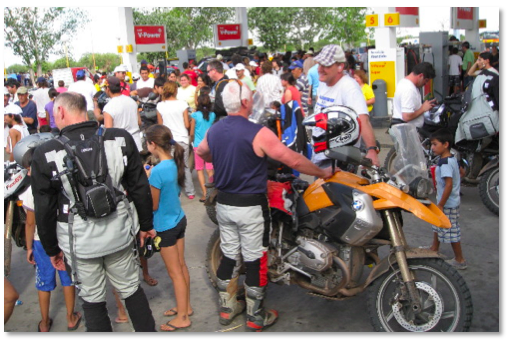
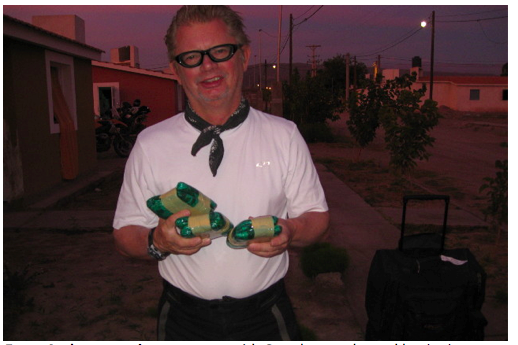
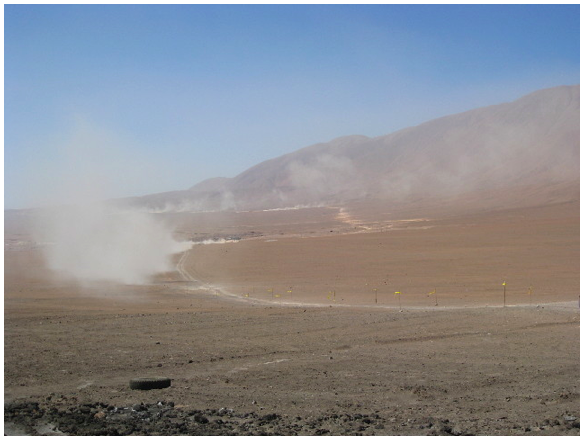
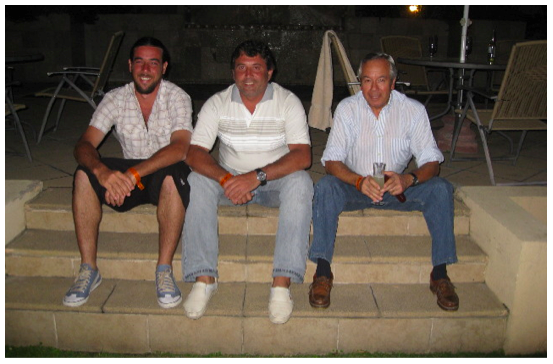
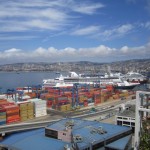
Ahhh, the trip improves now that your trusty steel steed has finally become trust worthy.
Yes, we’re heading in the right direction — literally and virtually. The true tests for Now Voyager lie ahead — the Atacama and a second attempt at going up the Andes. These will come in the next week. Stay tuned and keep all body parts crossed.
This is becoming my favorite weekend “show” – ‘what will KR & FW do this week? Stay TUNED!’
Ha! That’s funny Jayson…me too! I am loving the adventure show!
Where is the video??? Will there be video?
OK, I have some video. I need to work on getting it up, which I’ll start today. 🙂 fw
Fred and KR. Great. Enjoy both the “joys” and the “advdentures.” Keep at it. Vic